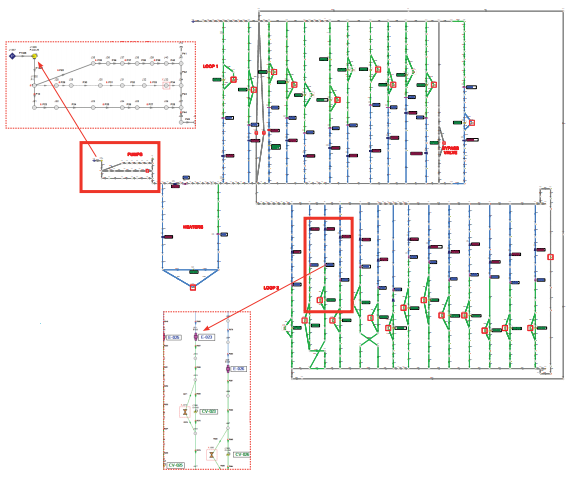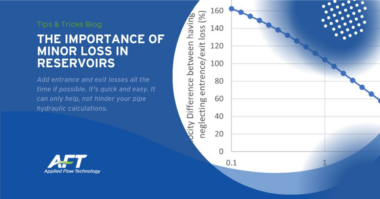Ingenero Technologies Pvt. Ltd.
Thane, India
Platinum Pipe Award Winner: Operational Benefits and Sustainability
Ingenero was able to save their client over $300,000 per year in energy costs after the client requested an analysis of a hot oil network in a petrochemical facility. They wanted to determine practical and cost-effective options to reduce power consumption and make the operation more energy efficient. The network used high pump discharge pressure and the pressure drops across certain control valves were excessively high.
The petrochemical production facility’s hot oil network has two hot oil pumps operating in parallel and two hot oil heaters which supply the hot oil to twenty-six heat exchangers.
The laterals to individual exchangers have control valves and flow elements. The plant was being operated at full load and the hot oil supply flow rates to individual consumers were at the maximum. The pump discharge pressure was observed to be 19.2 kg/cm2g (1,880 kPa-g/ 273 psig), and power consumption was observed to be about 2.1 MW.
The preliminary examination of plant operating data revealed that the pressure drops across certain control valves in the network were in the range of 8-9 kg/cm2 (785-880 kPa / 115-130 psid).
Ingenero proposed simulating the system using AFT Fathom so they could pinpoint and eliminate any design and operating anomalies in the network. The model was validated against the stable operating data reflecting the maximum required flow through individual exchangers. The control valves in the AFT Fathom model (Figure 1) were provided with the flow reading values as inputs and the model calculated the required Cv values for all the control valves. Based on the model predicted Cv values and the Cv vs opening characteristics available in the control valve datasheets, operating valve openings were predicted using Excel regression functionality. These predicted opening values were cross checked against the control valve opening values provided in the plant data.
It was observed that the deviation was within the +/- 5% range, indicating a good match. The model predicted pressures also showed an excellent match (+/-5%) with the plant pressure measurements available at various locations in the hot oil network. Based on this, it was concluded the AFT Fathom model was an accurate representation of the actual performance of the hot oil network.
The results of the validation model provided a lot of insight towards possible improvement options which were inconceivable by plant data analysis alone. It was decided that in terms of cost effectiveness and ease of implementation during plant shutdown, the most practical option was to modify certain flow elements and
control valves in the network.
The AFT Fathom model helped them evaluate various configuration changes. The final recommendations were:
- Minimum pressure drop (7 kg/cm / 685 kPa / 100 psid) was observed across flow control valve for exchanger E-023. By resizing and replacing the control valve for exchanger E-023, the hot oil pump discharge pressure can be reduced by 5.9 kg/cm2 (580 kPa / 84 psi), while maintaining the minimum pressure drop across all control valves at 0.5 kg/cm2 (50 kPa / 7 psid).
- Subsequent analysis using the model revealed the hot oil pump discharge pressure can be further reduced by 0.7 kg/cm2 (70 kPa / 10 psi) by modifying:
- Two flow elements in the laterals of exchangers E-023 and E-005 so they operate at pressure drop of 0.2 kg/cm2 (20 kPa / 3 psid) at required flow.
• Resizing and replacing the control valves of five exchangers so minimum pressure drop is 0.5 kg/cm2 (50 kPa / 7 psid) at required flow. - Using the operating requirement in terms of friction coefficients of flow elements and operating Cvs of control valves.
• While analyzing and proposing recommendations, characteristics of all old and new control valves were checked so expected operating range for opening would be within 20% and 70%.
Using AFT Fathom, Ingenero successfully pinpointed issues responsible for excessive power consumption. After replacing and properly sizing the two flow elements and total six control valves, it was evident the pump discharge pressure would be reduced from 19.2 kg/cm2g (1,880 kPa-g / 273 psig) to 12.6 kg/cm2g (1,240 kPa-g / 179 psig). The power consumption reduced from 2.1 MW to 1.22 MW – a 40% power reduction.
The recommendations of flow elements and control valve changes were implemented in the plant. New pumps with revised specifications were installed. The client was able to operate the network satisfactorily and the energy conservation was evident from plant operation.





Comments